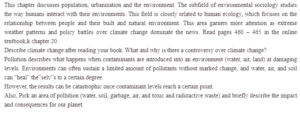Climate Change
Climterm’ ange’ refers t’ long-term temperature shifts because of human activities such as releasing greenhouse gases into the atmosphere (OpenStax 460). Many scientists have spent their time proving the existence of climate change, but the term remains controversial. Some countries view the limitation of some economic activities to reduce climate change. This led to the signing of the Kyoto Protocol to reduce the causes of climate change (OpenStax 461). However, some companies find this idea costly because they must invest heavily in regulations and operational upgrades to limit their toxic courses of action. OpenStax (2017) states this would harm the economy (461).
Moreover, some countries question the existence of climate change because scientists have failed to provide concrete evidence of its existence (OpenStax 461). The core countries, including Western Europe and the United States, were the primary sources of greenhouse gases and have evolved into postindustrial nations (OpenStax 461). Conversely, the peripheral and semi-peripheral countries that are now industrialized release significant quantities of greenhouse gases. The core countries wish to enact stringent measures regarding the causes of global warming in the current debate.
Furthermore, the peripheral and semi-peripheral nation-states aim to achieve the same economic opportunities so that their economies can evolve (OpenStax 461). Additionally, they argue that if the core countries insist on stringent green protocols, they need to pay some subsidies or offsets. This controversy makes it hard to address this conflict, mainly because it is unfair to the peripheral and semi-peripheral countries still dependent on greenhouse gas industries. Do you need help for completing your assignment ? We offer assignment help with high professionalism.
Radioactive Waste and its Impact and Consequences on the Planet
High-level radioactive waste is primarily linked with nuclear power generation and nuclear weapon production. Radioactivity is a form of air pollution. Detrimental impacts of radioactive decay include disrupting the food chain and causing harm to the microscopic and phytoplankton soil organisms (OpenStax 464). Consequently, inhaling residues could lead to cancer. According to Birkholzer, Houseworth, and Tsang (2012), the significant health risk linked with the disposal of nuclear waste is the imminent long-term low-level radioactive exposure, increasing the risk of genetic mutation or cancer (23). Radioactive pollution can also cause prolonged fires, like in the case of Centralia, Pennsylvania, which drove home displacements and the release of toxic gases into the environment, which put the surrounding communities at risk (OpenStax 465).
References
Birkholzer, Jens, Houseworth, James and Tsang Chin-Fu. “Geologic “disposal of high-level radioactive waste: Status, key issues, and trends.” Annual R” view of Environment and Resources 37 (2012): 79-106.
OpenStax. Introduction to Sociology 2e. Houston, Texas: Rice University, 2017.
ORDER A PLAGIARISM-FREE PAPER HERE
We’ll do everything from scratch
Question

Climate Change
This chapter discusses population, urbanization and the environment. The subfield of environmental sociology studies the way humans interact with their environments. This field is closely related to human ecology, which focuses on the relationship between people and their built and natural environment. This area garners more attention as extreme weather patterns and policy battles over climate change dominate the news. Read pages 460 – 465 in the online textbook,k chapter 20.
Describe climate change after reading your book. What and why is there a controversy over climate change?
Pollution describes what happens when contaminants are introduced into an environment (water, air, land) at damaging levels. Environments can often sustain a limited amount of pollutants without marked change, and water, air, and soil can “heal” the”selv”s to a certain degree.
However, the results can be catastrophic once contaminant levels reach a certain point.
Also, Pick an area of pollution (water, soil, garbage, air, and toxic and radioactive waste) and briefly describe the impact and consequences for our planet.

